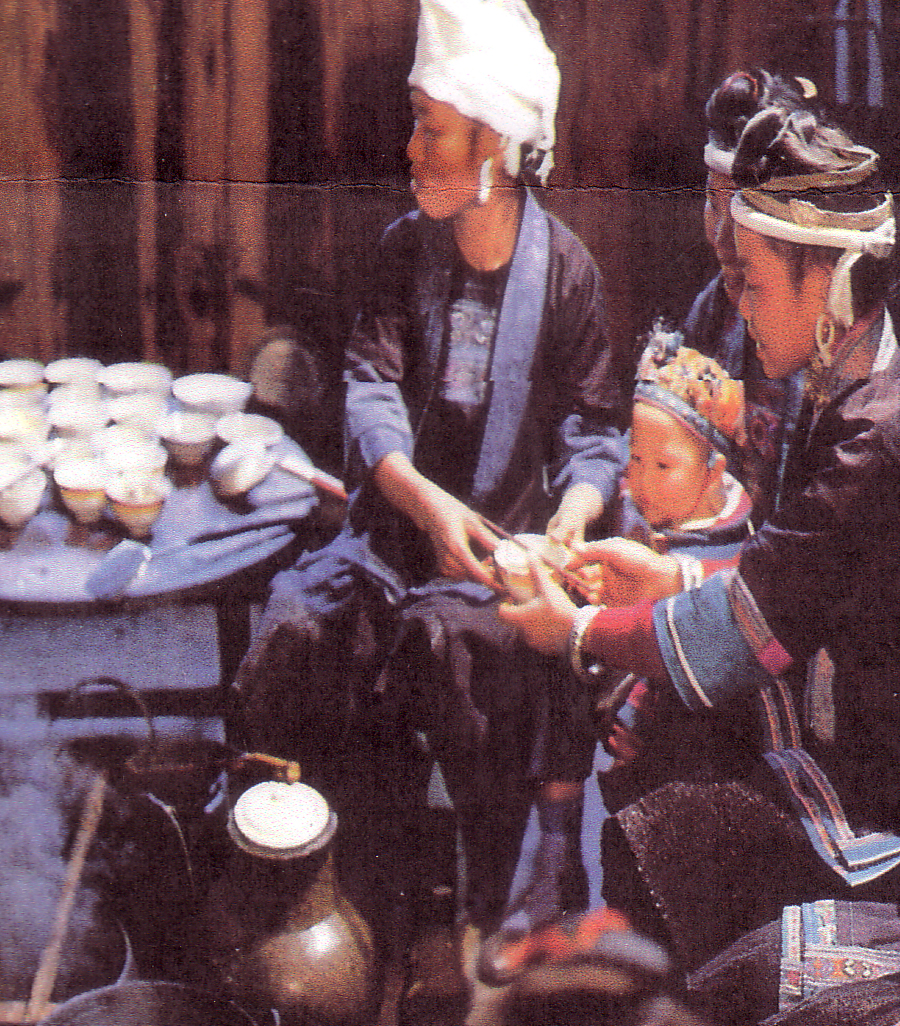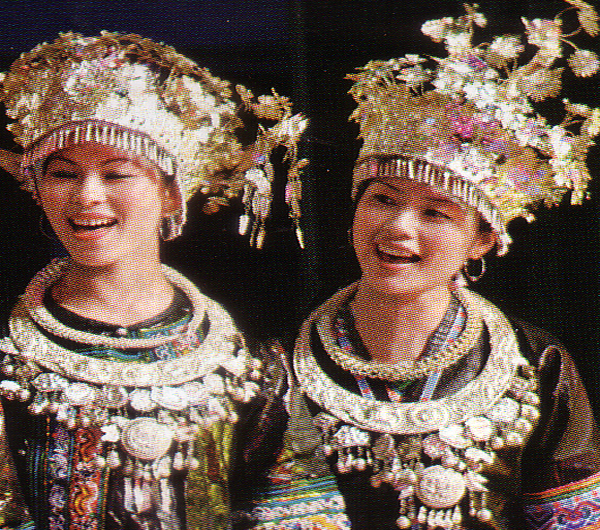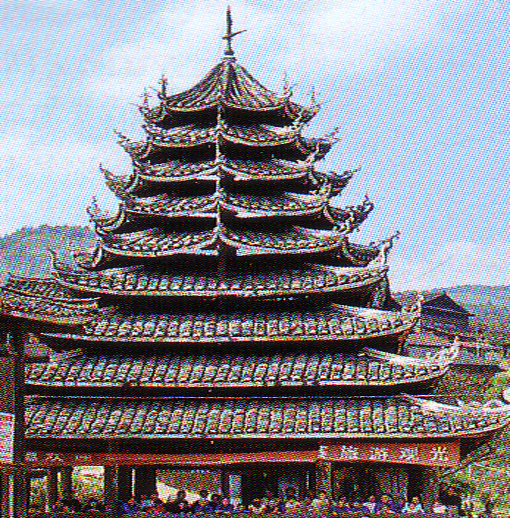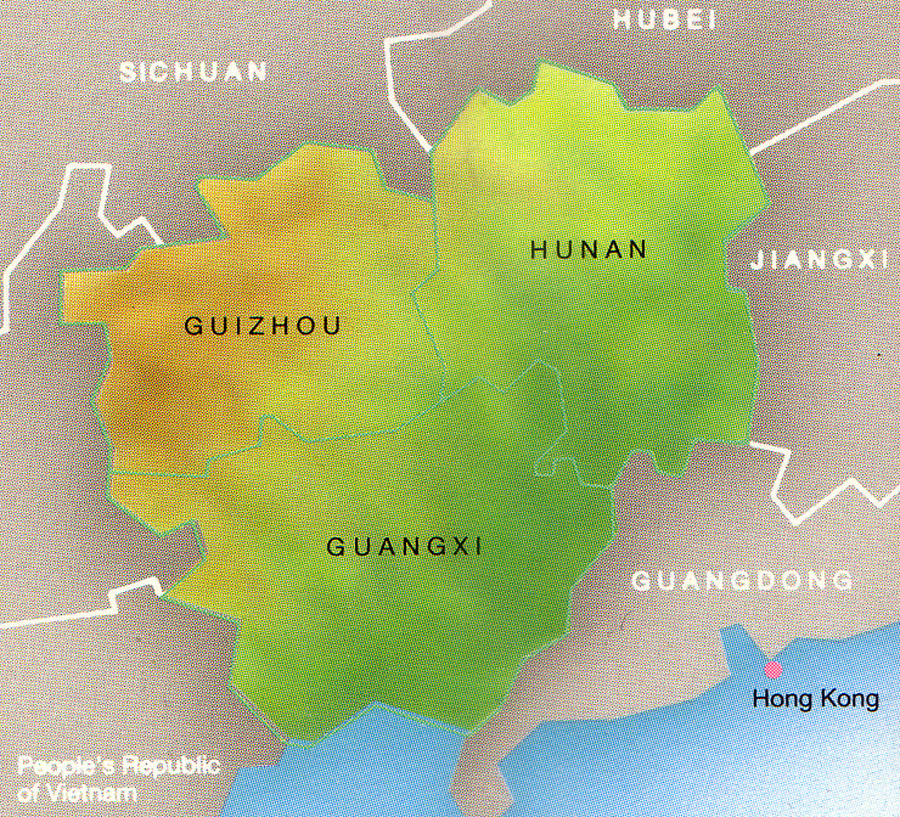
| What is Flavor and Fortune? |
| How do I subscribe? |
| How do I get past issues? |
| How do I advertise? |
| How do I contact the editor? |
Read 7003439 times
Connect me to:
| Home |
| Articles |
| Book reviews |
| Letters to the Editor |
| Newmans News and Notes |
| Recipes |
| Restaurant reviews |
| Article Index (all years, slow) |
| List of Article Years |
| Article Index (2024) |
| Article Index (last 2 years) |
| Things others say |
| Related Links |
| Log In... |
| Authors |
| Categories & Topics |
Dong People and Their Foods
| by Jacqueline M. Newman |
Chinese Ethnic Minorities and Their Foods
Winter Volume: 2012 Issue: 19(4) page(s): 20 - 22
This Chinese ethnic minority known as the Dongzu, number somewhat more than three million people. Most of them live in the Guizhou, Guangxi, Hubei, and Hunan Provinces and in the Guangxi-Zhuang Autonomous Prefecture.
 Thought descended from ancient Louyue or Liao people, those we now call Dong were, in the Qin Dynasty (221-207 BCE) thought to be called Qian Zhing Man. Reports say lots later they used the term 'Dong' and divided themselves into Southern Dong and Northern Dong, perhaps in the Song Dynasty (960 - 1279 CE), or at least some reports say that was when they did so. Many have since assimilated into the Han majority by marriage or in other ways, and many are still doing so. There are others who believe they were part of the Gelao people, also spelled Gelan, and that they became Dong in the Ming Dynasty (1368 - 1644 CE).
Thought descended from ancient Louyue or Liao people, those we now call Dong were, in the Qin Dynasty (221-207 BCE) thought to be called Qian Zhing Man. Reports say lots later they used the term 'Dong' and divided themselves into Southern Dong and Northern Dong, perhaps in the Song Dynasty (960 - 1279 CE), or at least some reports say that was when they did so. Many have since assimilated into the Han majority by marriage or in other ways, and many are still doing so. There are others who believe they were part of the Gelao people, also spelled Gelan, and that they became Dong in the Ming Dynasty (1368 - 1644 CE).
 Living in mountainous regions in South China, on the borders of the above provinces and mentioned prefecture, the Dong live among other ethnic groups including the Zhuang, Yao, Shui, Tujia, and the Miao people, speak the Zhuang-Dong dialect called Dongshui which is itself a Sino-Tibetan language, and they are a matriarchal society. These days, most Dong speak Mandarin and not their own dialect, and many have no surnames and instead distinguish themselves using their father's names.
Living in mountainous regions in South China, on the borders of the above provinces and mentioned prefecture, the Dong live among other ethnic groups including the Zhuang, Yao, Shui, Tujia, and the Miao people, speak the Zhuang-Dong dialect called Dongshui which is itself a Sino-Tibetan language, and they are a matriarchal society. These days, most Dong speak Mandarin and not their own dialect, and many have no surnames and instead distinguish themselves using their father's names.
Known for their embroidery, brocade, and cross-stitching, and for their Oil Tea called Dong Zu You Cha, they are also known for a Sour Duck they call Suan Ya. In the Tang Dynasty (618 - 907 CE) they became their own ethnic group and they did name themselves the Dong, do love to drink wine, love plums and peaches, pears, mushrooms, oranges, and watermelons, too.
 Dong People proudly build their homes, Wind and Rain Bridges, and their Drum Towers without nails and with an even numbers of floors. Their homes usually are two stories and with even numbers of sides. Many like to live on their odd-numbered floors, but keep in mind, the first raised floor is numbered one. Their Drum Towers can have close to sixteen floors and be sixty-five feet tall. They are supported by wooden pillars, most are polyhedral, and topped with a gourd-shaped spire; it represents peace and happiness. They also build Wind and Rain Bridges of wood with many sitting on huge stone piers. These have many corridors and pavilions, those at the end resembling palaces, the three in the middle resembling a pagoda, and each crowned with a gourd-shaped structure symbolizing good luck. These are places for socialization, weddings with much food, and places for boys to meet girls. They believe that foods feed the body, songs feed the soul.
Dong People proudly build their homes, Wind and Rain Bridges, and their Drum Towers without nails and with an even numbers of floors. Their homes usually are two stories and with even numbers of sides. Many like to live on their odd-numbered floors, but keep in mind, the first raised floor is numbered one. Their Drum Towers can have close to sixteen floors and be sixty-five feet tall. They are supported by wooden pillars, most are polyhedral, and topped with a gourd-shaped spire; it represents peace and happiness. They also build Wind and Rain Bridges of wood with many sitting on huge stone piers. These have many corridors and pavilions, those at the end resembling palaces, the three in the middle resembling a pagoda, and each crowned with a gourd-shaped structure symbolizing good luck. These are places for socialization, weddings with much food, and places for boys to meet girls. They believe that foods feed the body, songs feed the soul.
Staple foods of this population include regular and glutinous rice, millet, corn, wheat, and sorghum. Their favorite beverage is oil tea, and their favorite foods are sour, many pickled, and their high-quality native-grown Kam Sweet Rice. This oil tea can be their entire breakfast meal; it is certainly their most important one. It and many of their dinner dishes are well-known throughout the country; they are liked by Chinese everywhere in their country and abroad.
MAKING DONG OIL TEA means selecting tea leaves and stir-frying them in tea oil adding ginger and salt, then adding boiling water and some scallions. This they brew portion by portion in what many call their 'soup bowls.' In these large-size bowls they put fried sesame seeds, fried peanuts, cooked sticky rice, and slices of pork liver. Many also add some sugar; they do love their tea sweet. Often, they have this oil tea three times a day, and they say it is refreshing, warms the stomach, gets rid of colds, even prevents catching a cold. Dong Sour Duck is popular in Guizhou, Guangxi, Hubei, and Hunan. Many make theirs with an oil-tea mustard-vinegar sauce.
OIL-TEA SAUCE, DONG STYLE needs one-quarter cup dry mustard mixed with an equal amount of cold water, two tablespoons of rice vinegar added, and one-quarter teaspoon each of salt and sugar mixed into oil tea. Some Dong use this sauce to dip pieces of their meat or vegetables in. They eat these dipped items with their glutinous rice.
 Most Dong live in these three provinces and eat lots of rice, and supplement it at meals with wheat, beans of all sorts, melons, many different vegetables, pork, beef, chicken, and duck, eggs, and different ways of preparing fish. They like their food sour, so they make and eat a lot of pickled cabbage, pickled chili peppers, pickled chives, and pickled cabbage; and they consume lots of Oil Tea Sauce. Their pickled vegetables are mixed with glutinous rice powder and ground or chopped up chili peppers, and salt. This mixture is stored in large earthenware jars for half year or more. Some of this is the basis for and removed to make their Carp in Sour Soup. It can also be made adding a paste made of shrimp.
Most Dong live in these three provinces and eat lots of rice, and supplement it at meals with wheat, beans of all sorts, melons, many different vegetables, pork, beef, chicken, and duck, eggs, and different ways of preparing fish. They like their food sour, so they make and eat a lot of pickled cabbage, pickled chili peppers, pickled chives, and pickled cabbage; and they consume lots of Oil Tea Sauce. Their pickled vegetables are mixed with glutinous rice powder and ground or chopped up chili peppers, and salt. This mixture is stored in large earthenware jars for half year or more. Some of this is the basis for and removed to make their Carp in Sour Soup. It can also be made adding a paste made of shrimp.
SHRIMP PASTE, DONG STYLE is made with any pickled vegetables mashing the raw shrimp with chili and rice powders, ground dried ginger, ground cinnamon, and salt. This, too, is stored in crocks or jars for months, then fried before adding it to their Sour Soup, Sour Duck, or Fried or Roasted Stuffed Sour Carp prepared wrapping a fish in lemon grass. At dinner and late in the day, Dong adults drink sweet wine made from glutinous rice, corn, or sorghum; they like it alone or with any of their main dishes.
Dong, are known for their hospitality, merriment, their sour foods, and their embroidery. The women make a belt as a token of love to give to a favorite man. This public statement, if he accepts, says they are engaged. Another item of Dong recognition is one heard but not always seen. It is the Hua Bao Jie or Rocket Festival, a most important one in the life of a Dong. When it occurs, and it is not fixed on any calendar date, nor does it come every year, but when it does, one hears Dong on parade and their rockets or guns firing three rounds. Why three? One is for victory, one for unity, and the last for happiness.
On the beverage front, Salty Oil Tea is a Dong specialty. Visit a Dong family and you will be served some, most often with glutinous rice, tea oil, and tea leaves. Usually Yunwu Tea, they prefer this rare highland variety that comes with sun-dried glutinous rice fried and puffed in hot oil, and with some deep-fried peanuts or soy nuts mixed with the fried tea leaves. When these are removed from the oil, they are put into their large bowls and filled with boiling water along with the fried nuts and leaves and some chopped scallions. They like this with garlic leaves, but these are left on the side for garnish.
The lady of the house serves this tea to the eldest guest first, then on down to the youngest. After all guests have been served, family members come next, also oldest to youngest. If you are one of the guests, do not pick up your bowl until the hostess says, 'please' and do be attentive. If the hostess gives a male guest a single chopstick, she probably is sweet on him; he might be asked to have his before you have yours.
The custom is for every guest and every family member to enjoy four bowls of Dong Oil Tea. Do return your bowl to the hostess when empty and you are ready for more. The first three bowls will be salty, the last of them will be sweet. After the first bowl is served, note that everyone gets chopsticks; it will only be that one male, if any, to get a single one.
The chopstick(s) are for snacking. When done with tea and treats, put one or both across your bowl; that says you want or should not be served any more. By the way, if this chap is interested in her, he will drink an odd number of bowls of Dong tea and creatively eat with that one chopstick.
The Dong are most often of Sino-Tibetan heritage or they may be Thai. Wherever they are from, they celebrate a Reed-pipe Festival, make sacrifices to Cow Gods, and participate in a Dawu Mountain Singing Festival. They have other festivals including on New Years Day, Autumn Festival, Dragon Boat Festival, and a day called Sister's Festival. This last celebration is in memory of a heroine known as Yang Bamei. They cook ziba and eat this glutinous rice dish with the entire family there that day. Married women return that day to their natal home and bring some of this dish to their husband's home when they return there.
There is a New Rice-tasting Festival; this is a day when they cook some rice and worship their ancestors. Different villages celebrate on different days. There is a Dongnian Festival, and seven others unique to this ethnic group. On every festival and on every day, the Dong drink their oil tea with peanuts, sesame seeds, soybeans, tea leaves, and other goodies.
Dong women wear blue, black, purple, and white clothes, and they wear lots of silver jewelry. Some wear large silver headdresses, and many silver necklaces and bracelets. When they have lots of them on, it is probably a festival occasion, a day when they serve many festival foods. If invited, be honored and join them for a special meal, be honored to hear their polyphonic choral music in their Kgal Kaox Dong language, and their non-musical legends and tales.
Should it be a wedding, be prepared for a three-day affair, the first at the bride’s home, the last at the groom’s, and the one in between at a place they select or one of the above. If invited to a baby’s one month birthday, this is the day he/she gets their first haircut and is fed their first bowl of fermented juice. Five months later they have another celebration; this is when the baby gets its first taste of a meal with maize, millet, plums and other fruits, some vegetables, and some pig, fish, water buffalo, chicken, duck, and goose, some often barbecued.
If you are really a special guest, you and they will get their three to seven-year stored pickled meats. Be sure to tell your hostess how great they really are!
Dong food centers around their staples of rice, most often glutinous, other staples, lots of beans, many melons, and a plethora of vegetables. They like their food not just sour but also piquant and served with pickled chili, pickled cabbage, shredded radishes and cut-up chives, and glutinous rice powder, cooked glutinous rice, chili powder, and lots of salt. This mixture they prefer fermented and/or eaten when freshly made. In cold weather, they will also have Sour Soup with Fish, carp the preferred swimmer. This dish is easy to make as they remove the scales from the fish, then it goes into the soup with or without pickles and often with shrimp paste, preferably home-made.
Dong meals should have at least five courses. One is of rice, glutinous rice preferred, and it can be white, black, purple, brown, or red, alone or mixed, and cooked until soft. Another should be Ba Som which is stir-fried sour pork with chilies and garlic; another, their Sour Carp Soup. The beverages with this meal can be distilled glutinous rice wine and oil tea, the other dishes Ba Saa which is sour carp or another fish, Yau Cha wich is their oil tea with fried peanuts, fried glutinous rice, or any other dish or dishes.
| Sour Rice, Dong Style |
|---|
| Pickled Ginger, Dong Style |
|---|
| Bean Jelly with Hot Sauce, Dong Style |
|---|

Copyright © 1994-2024 by ISACC, all rights reserved
Address
3 Jefferson Ferry Drive
S. Setauket NY 11720